Intelligent Simultaneous Quantitative Online Analysis of Environmental Trace Heavy Metals with Total-Reflection X-Ray Fluorescence
Abstract
:1. Introduction
2. Related Work
| Research Area | Main Work | References |
|---|---|---|
| Basic components | Compact system construction | [8,9] |
| Parallel primary beam | [10] | |
| Polycapillary semi-lens | [11] | |
| Experimental conditions | Glancing angle optimization | [12,13] |
| Flowing nitrogen gas during detection | [14] | |
| Performance evaluation | Evaluation of accuracy, limits, etc. | [15,16,17,18] |
| Sample pretreatment | Direct treatment, mineralization, extraction, etc. | [19] |
| Ideal sample shape | [20] | |
| Pre-concentration | [21,22] | |
| Avoiding Hg volatilization | [23] | |
| Ultrasound-assisted extraction | [24] | |
| Vermicompost as adsorbent substrate | [25] | |
| Environmental applications | Analysis of environmental samples, etc. | [26,27,28,29,30,31,32,33,34,35,36,37,38,39,40,41,42,43,44,45,46,47,48] |
| Novel working modes | μ-TXRF | [49] |
| Sweeping-TXRF | [50] | |
| Related applications | [51,52,53] |
3. Online TXRF Analysis Platform
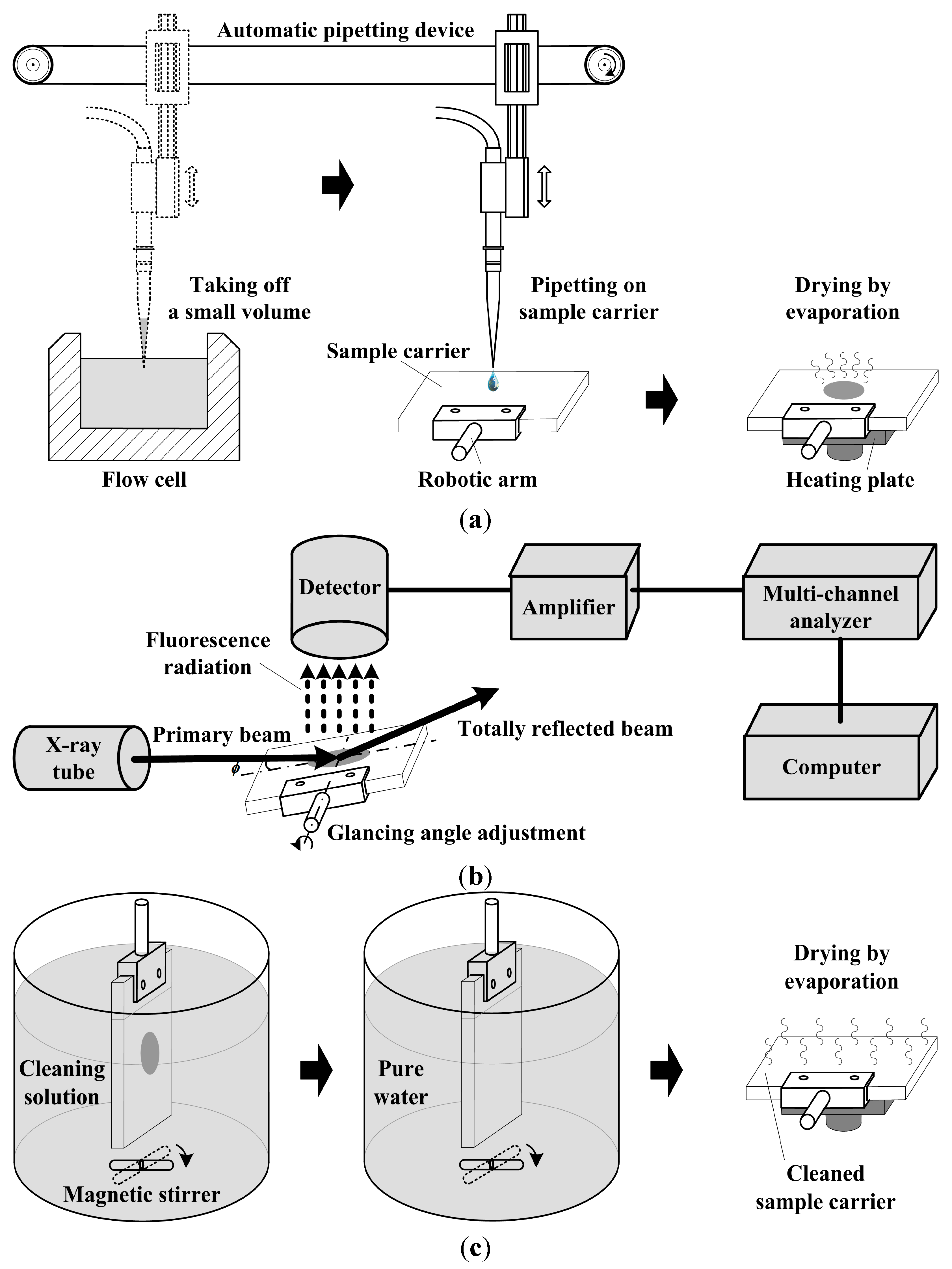
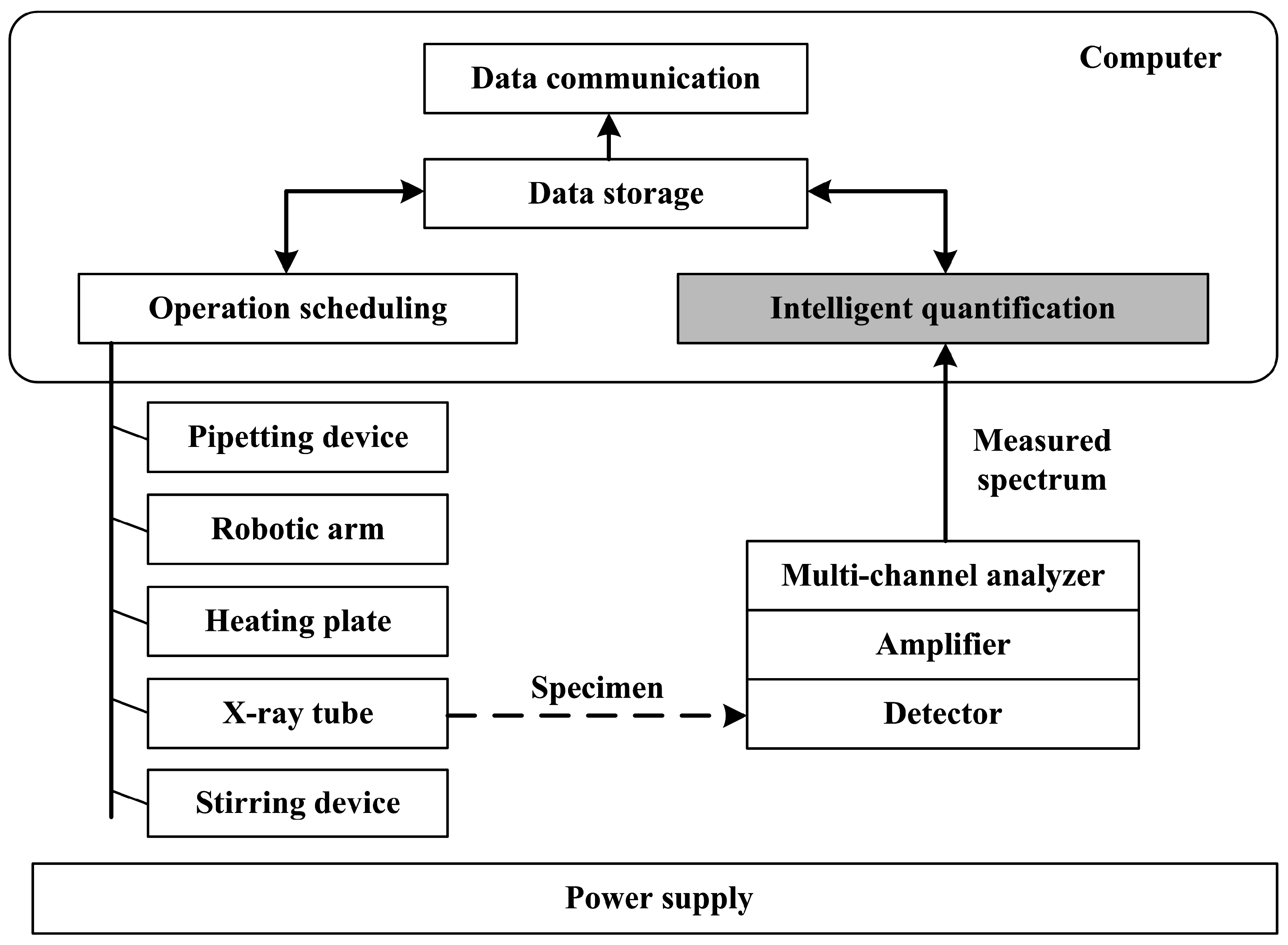
4. Intelligent Quantification Method for Online TXRF Analysis
4.1. Spectral Decomposition Framework

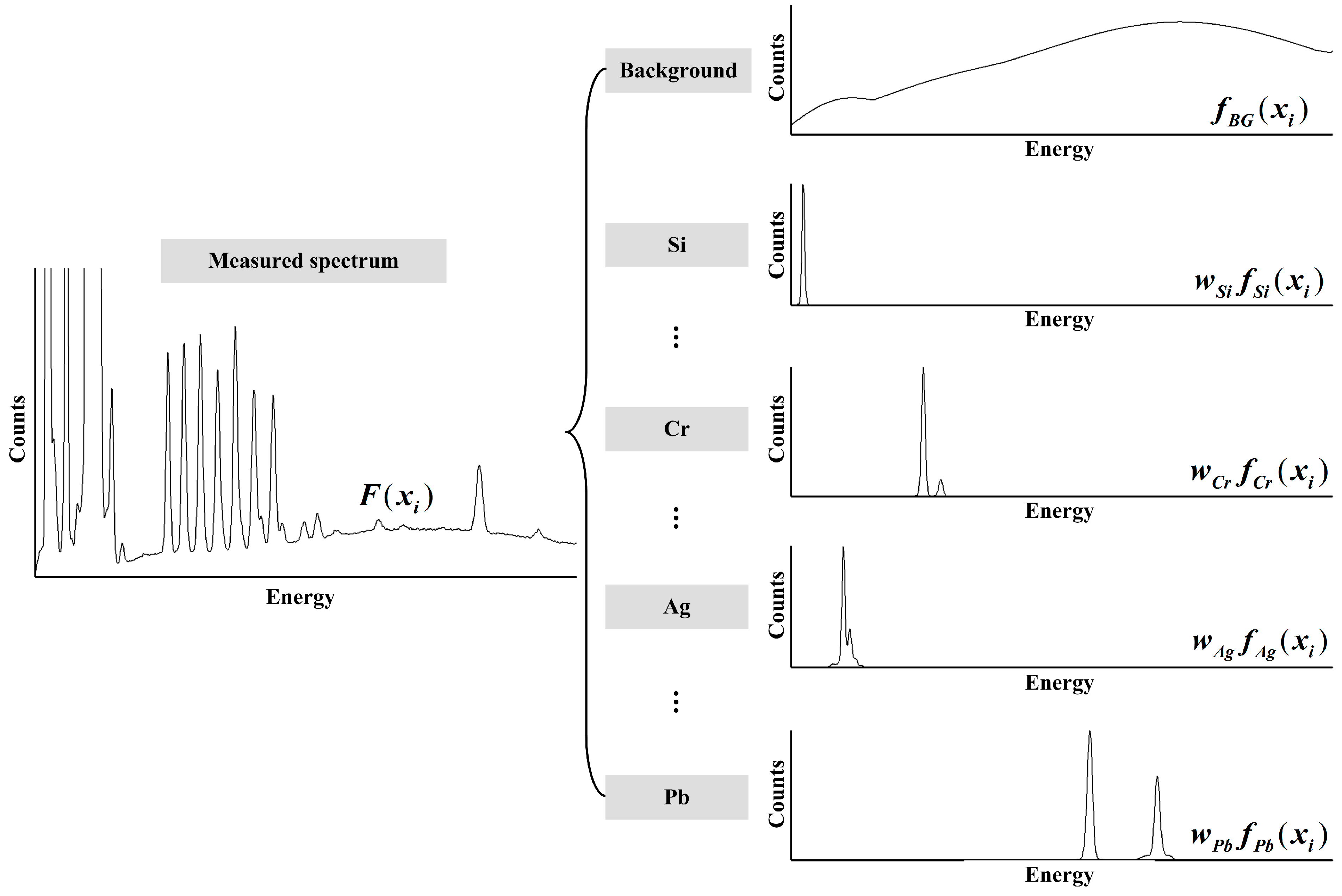
4.2. Formulation of Optimization Problem
4.3. PSO-RBFN-SA Algorithm
| Algorithm 1. PSO-RBFN-SA |
|
| prepared spectra are used as samples for RBFN training. |
| For |
| PSO is performed to the spectrum , and the population of particles is set as . |
| For |
|
represents the current solution, which is initialized as a random solution in the solution space:
|
|
represents the current velocity, which is initialized as a random velocity:
|
|
represents the best solution it has achieved so far, which is initialized as:
|
| End |
| The maximum iteration of PSO is set as . |
| For |
| The global best solution
is defined as:
|
| For |
| The weighted particle velocity is updated as:
|
| The solution of each particle is updated as:
|
| The best position of particle is calculated as:
|
| End |
| End |
| The global optimization result of is recorded as . |
| End |
| RBFN is trained with the optimization results, where the training inputs are defined as:
|
|
| The global optimization result of each online measured spectrum
is inferred by the constructed RBFN, where the input is set as:
|
| The output is calculated as:
|
| For |
| The cooling condition is that the best state remains unchanged for times. |
| While the cooling condition is not satisfied |
| Use a perturbation mechanism to generate a new state
:
|
| The decrease of fitness is:
|
| Check whether the new state should be accepted according to Metropolis criteria:
|
| End |
| Cool down with a parameter
:
|
| End |
| The result of is returned to calculate multi-element concentrations. |
5. Experimental Results
5.1. Experimental Settings
5.2. Performance Evaluation
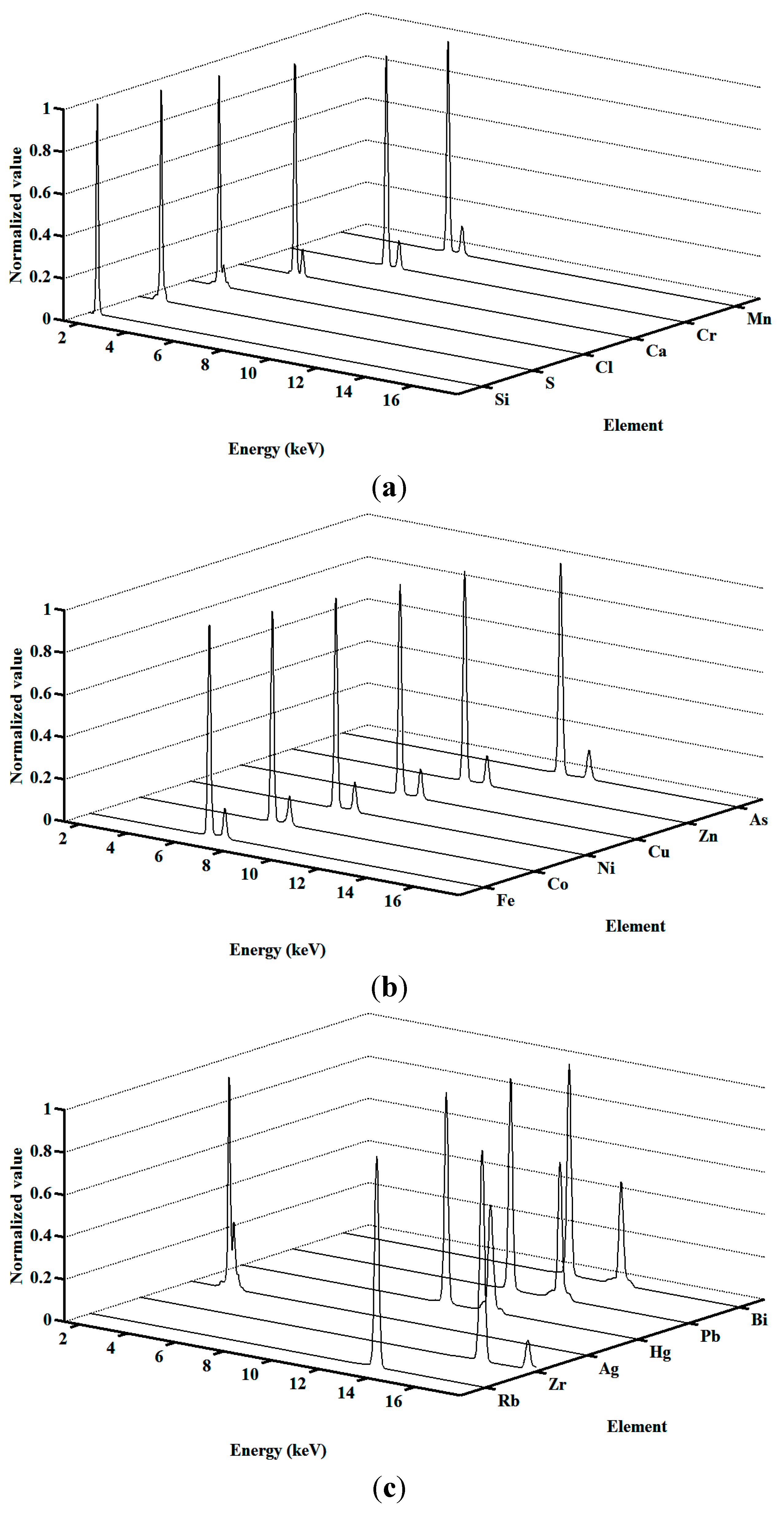
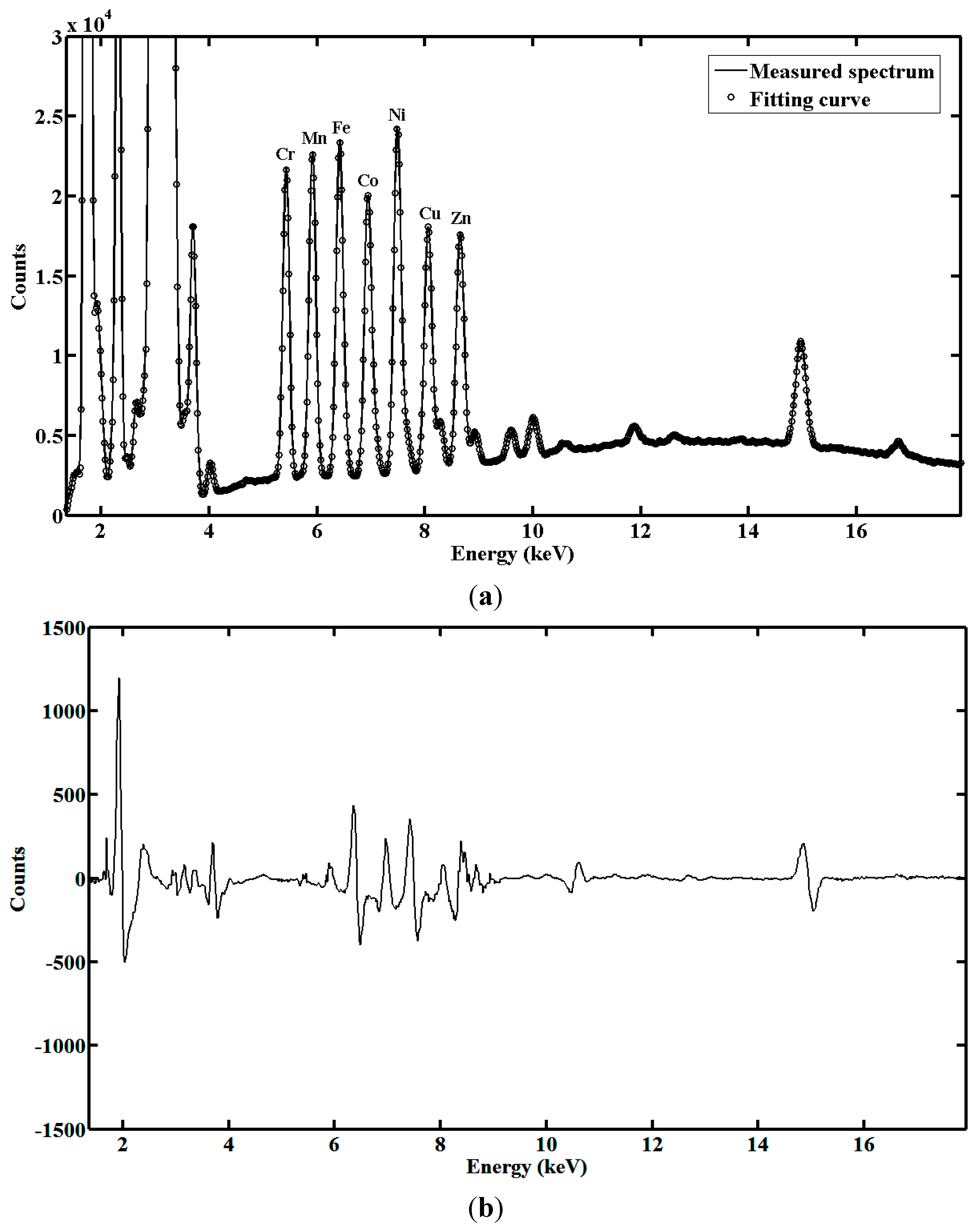
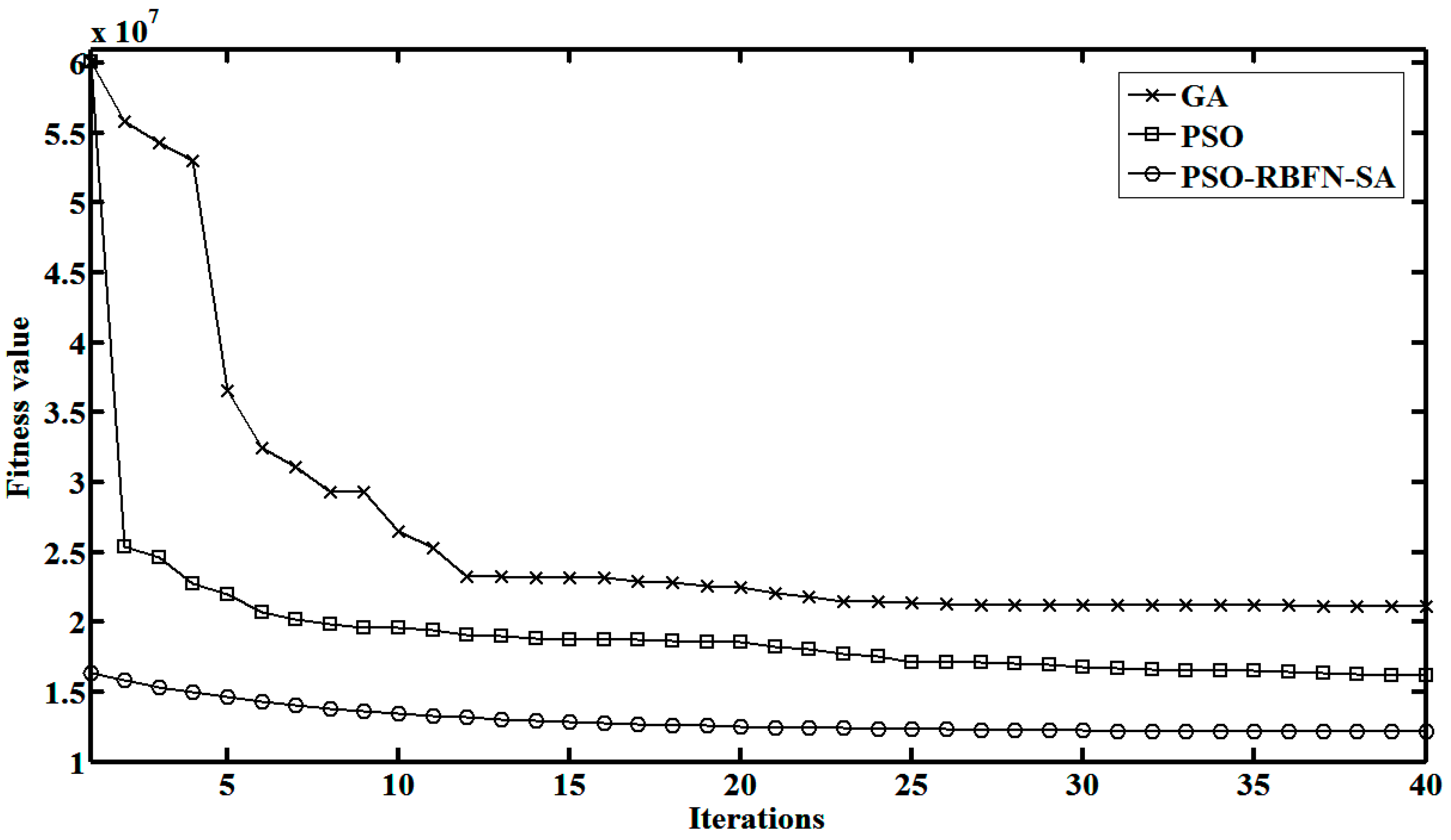
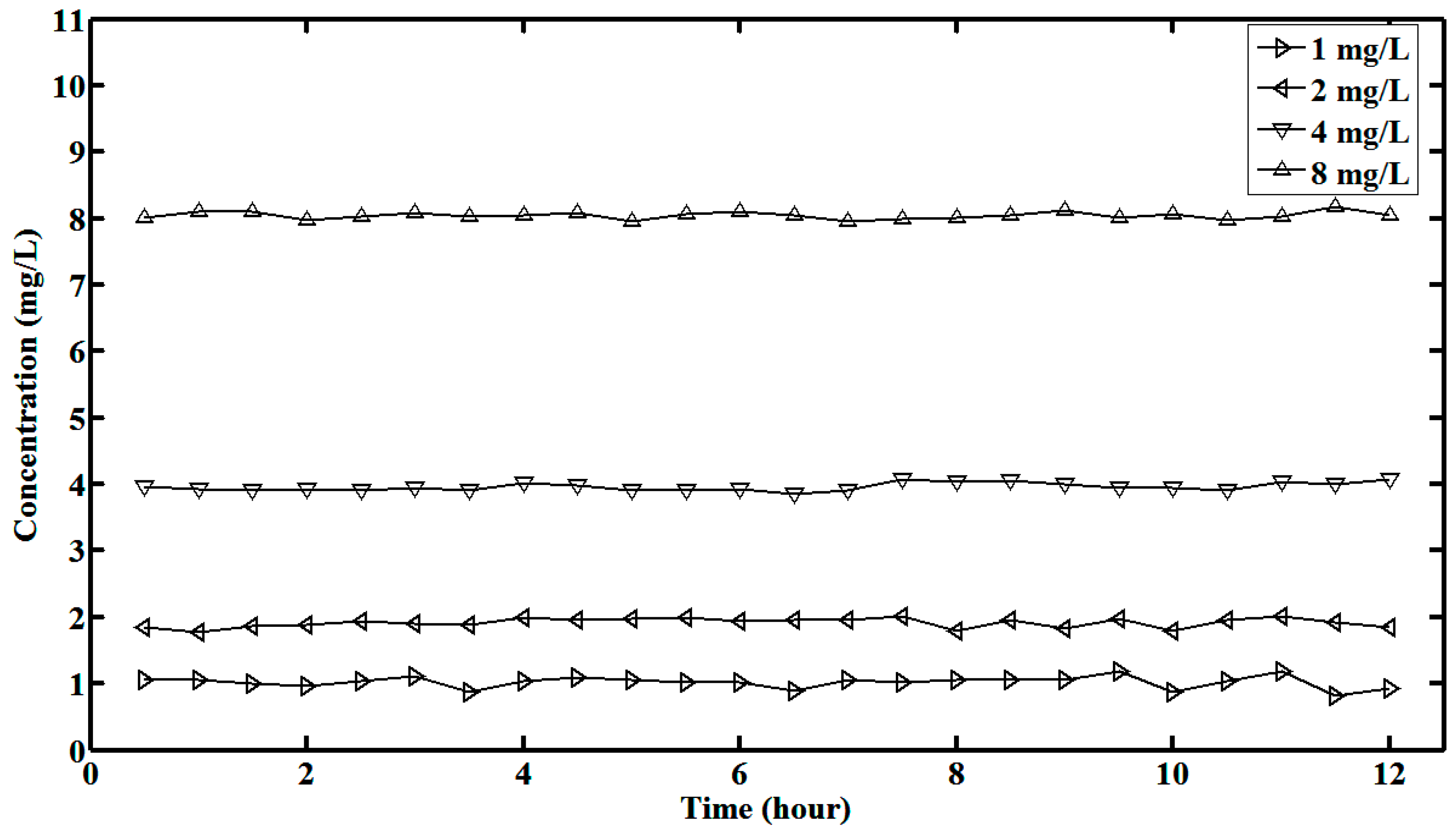
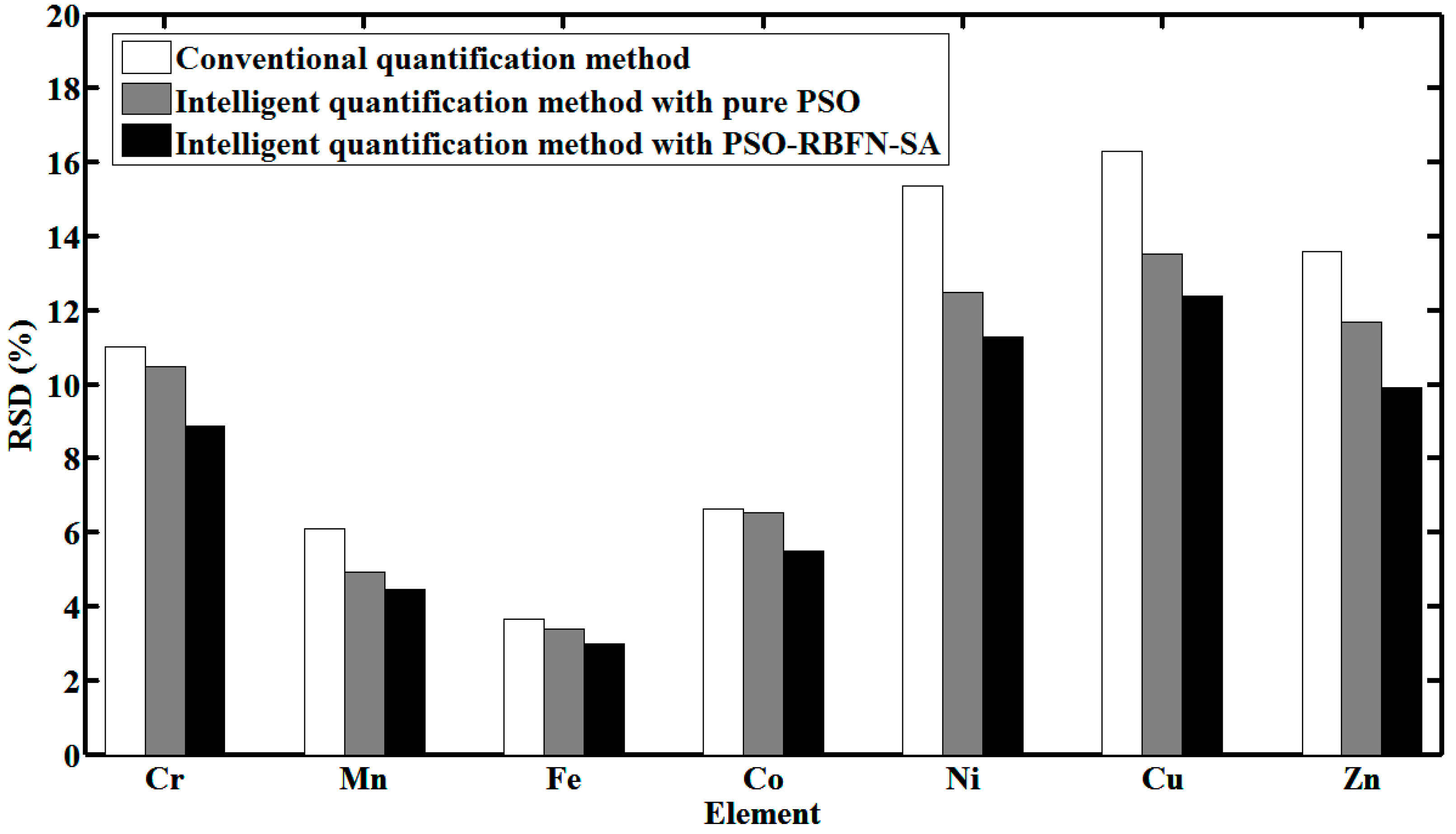
6. Conclusions
Acknowledgments
Author Contributions
Conflicts of Interest
References
- Wobrauschek, P.; Streli, C. Total reflection X-ray fluorescence. Encycl. Anal. Chem. 2006, 6, 1–30. [Google Scholar]
- Wobrauschek, P. Total reflection X-ray fluorescence analysis: A review. X-Ray Spectrom. 2007, 36, 289–300. [Google Scholar] [CrossRef]
- Ma, J.; Yang, Q.; Wang, Y.; Yang, K.; Liu, Y.; Zhao, Y. Research progress of rapid monitoring technology for heavy metals in soils. Environ. Monit. China 2015, in press. [Google Scholar]
- Wang, X.; Ma, J.; Wang, S. Distributed energy optimization for target tracking in wireless sensor networks. IEEE Trans. Mob. Comput. 2009, 9, 73–86. [Google Scholar] [CrossRef]
- Wang, X.; Ma, J.; Wang, S. Parallel energy-efficient coverage optimization with maximum entropy clustering in wireless sensor networks. J. Parallel Distrib. Comput. 2009, 69, 838–847. [Google Scholar] [CrossRef]
- Wang, X.; Wang, S.; Ma, J. An improved particle filter for target tracking in sensor systems. Sensors 2007, 7, 144–156. [Google Scholar] [CrossRef]
- Wang, X.; Ma, J.; Wang, S.; Bi, D. Distributed particle swarm optimization and simulated annealing for energy-efficient coverage in wireless sensor networks. Sensors 2007, 7, 628–648. [Google Scholar] [CrossRef]
- Tiwari, M.K.; Sawhney, K.J.S.; Gowri Sankar, B.; Raghuvanshi, V.K.; Nandedkar, R.V. A simple and precise total reflection X-ray fluorescence spectrometer: Construction and its applications. Spectrochim. Acta Part B At. Spectrosc. 2004, 59, 1141–1147. [Google Scholar] [CrossRef]
- Ayala Jiménez, R.E. Total reflection X-ray fluorescence spectrometers for multielement analysis: Status of equipment. Spectrochim. Acta Part B At. Spectrosc. 2001, 56, 2331–2336. [Google Scholar]
- Korotkikh, E.M. Total reflection X-ray fluorescence spectrometer with parallel primary beam. X-Ray Spectrom. 2006, 35, 116–119. [Google Scholar] [CrossRef]
- Hampai, D.; Dabagov, S.B.; Polese, C.; Liedl, A.; Cappuccio, G. Laboratory total reflection X-ray fluorescence analysis for low concentration samples. Spectrochim. Acta Part B At. Spectrosc. 2014, 101, 114–117. [Google Scholar] [CrossRef]
- Bernasconi, G.; Dargie, M.; Jaib, M.M.; Tajani, A. Total reflection X-ray fluorescence analysis under various experimental conditions. X-Ray Spectrom. 1997, 26, 203–210. [Google Scholar] [CrossRef]
- Kunimura, S.; Watanabe, D.; Kawai, J. Optimization of a glancing angle for simultaneous trace elemental analysis by using a portable total reflection X-ray fluorescence spectrometer. Spectrochim. Acta Part B At. Spectrosc. 2009, 64, 288–290. [Google Scholar] [CrossRef]
- Imashuku, S.; Tee, D.P.; Kawai, J. Improvement of total reflection X-ray fluorescence spectrometer sensitivity by flowing nitrogen gas. Spectrochim. Acta Part B At. Spectrosc. 2012, 73, 75–78. [Google Scholar] [CrossRef]
- Kunimura, S.; Kawai, J. Trace elemental determination by portable total reflection X-ray fluorescence spectrometer with low wattage X-ray tube. X-Ray Spectrom. 2013, 42, 171–173. [Google Scholar] [CrossRef]
- Tiwari, M.K.; Gowrishankar, B.; Raghuvanshi, V.K.; Nandedkar, R.V.; Sawhney, K.J.S. Development of a total reflection X-ray fluorescence spectrometer for ultra-trace element analysis. Bull. Mater. Sci. 2002, 25, 435–441. [Google Scholar] [CrossRef]
- Sánchez, H.J. Detection limit calculations for the total reflection techniques of X-ray fluorescence analysis. Spectrochim. Acta Part B At. Spectrosc. 2001, 56, 2027–2036. [Google Scholar] [CrossRef]
- Cherkashina, T.Y.; Panteeva, S.V.; Finkelshtein, A.L.; Makagon, V.M. Determination of Rb, Sr, Cs, Ba, and Pb in K-feldspars in small sample amounts by total reflection X-ray fluorescence. X-Ray Spectrom. 2013, 42, 207–212. [Google Scholar] [CrossRef]
- De La Calle, I.; Cabaleiro, N.; Romero, V.; Lavilla, I.; Bendicho, C. Sample pretreatment strategies for total reflection X-ray fluorescence analysis: A tutorial review. Spectrochimica Acta Part B Atomic Spectroscopy 2013, 90, 23–54. [Google Scholar] [CrossRef]
- Horntrich, C.; Kregsamer, P.; Prost, J.; Stadlbauer, F.; Wobrauschek, P.; Streli, C. Production of the ideal sample shape for total reflection X-ray fluorescence analysis. Spectrochim. Acta Part B At. Spectrosc. 2012, 77, 31–34. [Google Scholar] [CrossRef]
- Kump, P.; Nečemer, M.; Veber, M. Determination of trace elements in mineral water using total reflection X-ray fluorescence spectrometry after preconcentration with Ammonium Pyrrolidinedithiocarbamate. X-Ray Spectrom. 1997, 26, 232–236. [Google Scholar] [CrossRef]
- Barros, H.; Marcó Parra, L.M.; Bennun, L.; Greaves, E.D. Determination of arsenic in water samples by total reflection X-ray fluorescence using pre-concentration with alumina. Spectrochim. Acta Part B At. Spectrosc. 2010, 65, 489–492. [Google Scholar] [CrossRef]
- Marguí, E.; Kregsamer, P.; Hidalgo, M.; Tapias, J.; Queralt, I.; Streli, C. Analytical approaches for Hg determination in wastewater samples by means of total reflection X-ray fluorescence spectrometry. Talanta 2010, 82, 821–827. [Google Scholar] [CrossRef] [PubMed]
- De La Calle, I.; Cabaleiro, N.; Lavilla, I.; Bendicho, C. Ultrasound-assisted single extraction tests for rapid assessment of metal extractability from soils by total reflection X-ray fluorescence. J. Hazard. Mater. 2013, 260, 202–209. [Google Scholar] [CrossRef] [PubMed]
- Urdaneta, C.; Parra, L.M.M.; Matute, S.; Garaboto, M.A.; Barros, H.; Vázquez, C. Evaluation of vermicompost as bioadsorbent substrate of Pb, Ni, V and Cr for waste waters remediation using total reflection X-ray fluorescence. Spectrochim. Acta Part B At. Spectrosc. 2008, 63, 1455–1460. [Google Scholar] [CrossRef]
- Macedo-Miranda, M.G.; Zarazua, G.; Mejia-Zarate, E.; Avila-Pérez, P.; Barrientos-Becerra, B.; Tejeda, S. Simultaneous determination of elemental content in water samples by total reflection X-ray fluorescence and atomic absorption spectrometry. J. Radioanal. Nucl. Chem. 2009, 280, 427–430. [Google Scholar] [CrossRef]
- Klockenkämper, R.; von Bohlen, A. Elemental analysis of environmental samples by total reflection X-ray fluorescence: A review. X-Ray Spectrom. 1996, 25, 156–162. [Google Scholar] [CrossRef]
- Borgese, L.; Bilo, F.; Tsuji, K.; Fernández-Ruiz, R.; Margui, E.; Streli, C.; Depero, L.E. First total reflection X-ray fluorescence round-robin test of water samples: Preliminary results. Spectrochim. Acta Part B At. Spectrosc. 2014, 101, 6–14. [Google Scholar] [CrossRef]
- Pashkova, G.V.; Revenko, A.G.; Finkelshtein, A.L. Study of factors affecting the results of natural water analyses by total reflection X-ray fluorescence. X-Ray Spectrom. 2013, 42, 524–530. [Google Scholar] [CrossRef]
- Dhara, S.; Misra, N.L. Application of total reflection X-ray fluorescence spectrometry for trace elemental analysis of rainwater. Pramana 2011, 76, 361–366. [Google Scholar] [CrossRef]
- De Vives, A.E.S.; Moreira, S.; Brienza, S.M.B.; Medeiros, J.G.S.; Tomazello Filho, M.; Zucchi, O.L.A.D.; do Nascimento Filho, V.F. Monitoring of the environmental pollution by trace element analysis in tree-rings using synchrotron radiation total reflection X-ray fluorescence. Spectrochim. Acta Part B At. Spectrosc. 2006, 61, 1170–1174. [Google Scholar] [CrossRef]
- Olsson, M.; Viksna, A.; Helmisaari, H.S. Multi-element analysis of fine roots of Scots pine by total reflection X-ray fluorescence spectrometry. X-Ray Spectrom. 1999, 28, 335–338. [Google Scholar] [CrossRef]
- Marguí, E.; Tapias, J.C.; Casas, A.; Hidalgo, M.; Queralt, I. Analysis of inlet and outlet industrial wastewater effluents by means of benchtop total reflection X-ray fluorescence spectrometry. Chemosphere 2010, 80, 263–270. [Google Scholar] [CrossRef] [PubMed]
- Tavares, G.A.; Almeida, E.; de Oliveira, J.G.G.; Bendassolli, J.A.; Nascimento Filho, V.F. Elemental content in deionized water by total-reflection X-ray fluorescence spectrometry. J. Radioanal. Nucl. Chem. 2011, 287, 377–381. [Google Scholar] [CrossRef]
- De La Calle, I.; Quade, M.; Krugmann, T.; Fittschen, U.E.A. Determination of residual metal concentration in metallurgical slag after acid extraction using total reflection X-ray fluorescence spectrometry. X-Ray Spectrom. 2014, 43, 345–352. [Google Scholar] [CrossRef]
- Stosnach, H. On-site analysis of heavy metal contaminated areas by means of total reflection X-ray fluorescence analysis (TXRF). Spectrochim. Acta Part B At. Spectrosc. 2006, 61, 1141–1145. [Google Scholar] [CrossRef]
- Novikova, N.N.; Zheludeva, S.I.; Konovalov, O.V.; Kovalchuk, M.V.; Stepina, N.D.; Myagkov, I.V.; Yanusova, L.G. Total reflection X-ray fluorescence study of Langmuir monolayers on water surface. J. Appl. Crystallogr. 2003, 36, 727–731. [Google Scholar] [CrossRef]
- Carvalho, M.L.; Barreiros, M.A.; Costa, M.M.; Ramos, M.T.; Marques, M.I. Study of heavy metals in Madeira wine by total reflection X-ray fluorescence analysis. X-Ray Spectrom. 1996, 25, 29–32. [Google Scholar] [CrossRef]
- Ribeiro, R.O.R.; Mársico, E.T.; Jesus, E.F.O.; Silva Carneiro, C.; Júnior, C.A.C.; Almeida, E. Determination of trace elements in honey from different regions in Rio de Janeiro State (Brazil) by total reflection X-ray fluorescence. J. Food Sci. 2014, 79, 738–742. [Google Scholar] [CrossRef]
- Moreira, S.; Fazza, E.V. Evaluation of water and sediment of the Graminha and Águas da Serra streams in the city of Limeira (Sp-Brazil) by synchrotron radiation total reflection X-ray fluorescence. Spectrochim. Acta Part B At. Spectrosc. 2008, 63, 1432–1442. [Google Scholar] [CrossRef]
- Martinez, T.; Zarazua, G.; Avila-Perez, P.; Juarez, F.; Cabrera, L.; Martinez, G. Characterization by total reflection X-ray fluorescence spectrometry of filtered water into the cave under the Sun Pyramid in Teotihuacan city. Spectrochim. Acta Part B At. Spectrosc. 2008, 63, 1420–1425. [Google Scholar] [CrossRef]
- Lattuada, R.M.; Menezes, C.T.B.; Pavei, P.T.; et al. Determination of metals by total reflection X-ray fluorescence and evaluation of toxicity of a river impacted by coal mining in the south of Brazil. J. Hazard. Mater. 2009, 163, 531–537. [Google Scholar] [CrossRef]
- Zarazua, G.; Ávila-Pérez, P.; Tejeda, S.; Barcelo-Quintal, I.; Martínez, T. Analysis of total and dissolved heavy metals in surface water of a Mexican polluted river by total reflection X-ray fluorescence spectrometry. Spectrochim. Acta Part B At. Spectrosc. 2006, 61, 1180–1184. [Google Scholar] [CrossRef]
- Valentinuzzi, M.C.; Sánchez, H.J.; Abraham, J. Total reflection X-ray fluorescence analysis of river waters in its stream across the city of Cordoba, in Argentina. Spectrochim. Acta Part B At. Spectrosc. 2006, 61, 1175–1179. [Google Scholar] [CrossRef]
- Marques, A.F.; Queralt, I.; Carvalho, M.L.; Bordalo, M. Total reflection X-ray fluorescence and energy-dispersive X-ray fluorescence analysis of runoff water and vegetation from abandoned mining of Pb-Zn ores. Spectrochim. Acta Part B At. Spectrosc. 2003, 58, 2191–2198. [Google Scholar] [CrossRef]
- Costa, A.C.M.; Anjos, M.J.; Moreira, S.; Lopes, R.T.; de Jesus, E.F.O. Analysis of mineral water from Brazil using total reflection X-ray fluorescence by synchrotron radiation. Spectrochim. Acta Part B At. Spectrosc. 2003, 58, 2199–2204. [Google Scholar] [CrossRef]
- Costa, A.C.M.; Anjos, M.J.; Lopes, R.T.; Pérez, C.A.; Castro, C.R.F. Multi-element analysis of sea water from Sepetiba Bay, Brazil, by total reflection X-ray fluorescence spectrometry using synchrotron radiation. X-Ray Spectrom. 2005, 34, 183–188. [Google Scholar] [CrossRef]
- Costa, A.C.M.; Castro, C.R.F.; Anjos, M.J.; Lopes, R.T. Multielement determination in river-water of Sepetiba Bay tributaries (Brazil) by total reflection X-ray fluorescence using synchrotron radiation. J. Radioanal. Nucl. Chem. 2006, 269, 703–706. [Google Scholar] [CrossRef]
- Tsuji, K.; Kawamata, M.; Nishida, Y.; Nakano, K.; Sasaki, K.I. Micro total reflection X-ray fluorescence (µ-TXRF) analysis. X-Ray Spectrom. 2006, 35, 375–378. [Google Scholar] [CrossRef]
- Mori, Y.; Uemura, K.; Kohno, H.; Yamagami, M.; Iizuka, Y. Sweeping-TXRF: A nondestructive technique for the entire surface characterization of metal contaminations on semiconductor wafers. IEEE Trans. Semicond. Manuf. 2005, 18, 569–574. [Google Scholar] [CrossRef]
- Klockenkämper, R. Challenges of total reflection X-ray fluorescence for surface-and thin-layer analysis. Spectrochim. Acta Part B At. Spectrosc. 2006, 61, 1082–1090. [Google Scholar] [CrossRef]
- Liou, B.W.; Lee, C.L. Applications of total reflection X-ray fluorescence to analysis of VLSI micro contamination. IEEE Trans. Semicond. Manuf. 1999, 12, 266–268. [Google Scholar] [CrossRef]
- Hellin, D.; De Gendt, S.; Rip, J.; Vinckier, C. Total reflection X-ray fluorescence spectrometry for the introduction of novel materials in clean-room production environments. IEEE Trans. Device Mater. Reliab. 2005, 5, 639–651. [Google Scholar] [CrossRef]
- Margui, E.; van Grieken, R. X-Ray Fluorescence Spectrometry and Related Techniques; Momentum Press: New York, NY, USA, 2013. [Google Scholar]
- Reinhold, K. Total-reflection X-ray Fluorescence Analysis; Wiley-Interscience: New York, NY, USA, 1997. [Google Scholar]
- Wang, X.; Ma, J.; Ding, L.; Bi, D. Robust forecasting for energy efficiency of wireless multimedia sensor networks. Sensors 2007, 7, 2779–2807. [Google Scholar] [CrossRef]
- Wang, X.; Ma, J.; Wang, S.; Bi, D. Time series forecasting energy-efficient organization of wireless sensor networks. Sensors 2007, 7, 1766–1792. [Google Scholar] [CrossRef]
- Wang, X.; Ma, J.; Wang, S.; Bi, D. Cluster-based dynamic energy management for collaborative target tracking in wireless sensor networks. Sensors 2007, 7, 1193–1215. [Google Scholar] [CrossRef]
© 2015 by the authors; licensee MDPI, Basel, Switzerland. This article is an open access article distributed under the terms and conditions of the Creative Commons Attribution license (http://creativecommons.org/licenses/by/4.0/).
Share and Cite
Ma, J.; Wang, Y.; Yang, Q.; Liu, Y.; Shi, P. Intelligent Simultaneous Quantitative Online Analysis of Environmental Trace Heavy Metals with Total-Reflection X-Ray Fluorescence. Sensors 2015, 15, 10650-10675. https://doi.org/10.3390/s150510650
Ma J, Wang Y, Yang Q, Liu Y, Shi P. Intelligent Simultaneous Quantitative Online Analysis of Environmental Trace Heavy Metals with Total-Reflection X-Ray Fluorescence. Sensors. 2015; 15(5):10650-10675. https://doi.org/10.3390/s150510650
Chicago/Turabian StyleMa, Junjie, Yeyao Wang, Qi Yang, Yubing Liu, and Ping Shi. 2015. "Intelligent Simultaneous Quantitative Online Analysis of Environmental Trace Heavy Metals with Total-Reflection X-Ray Fluorescence" Sensors 15, no. 5: 10650-10675. https://doi.org/10.3390/s150510650
APA StyleMa, J., Wang, Y., Yang, Q., Liu, Y., & Shi, P. (2015). Intelligent Simultaneous Quantitative Online Analysis of Environmental Trace Heavy Metals with Total-Reflection X-Ray Fluorescence. Sensors, 15(5), 10650-10675. https://doi.org/10.3390/s150510650





